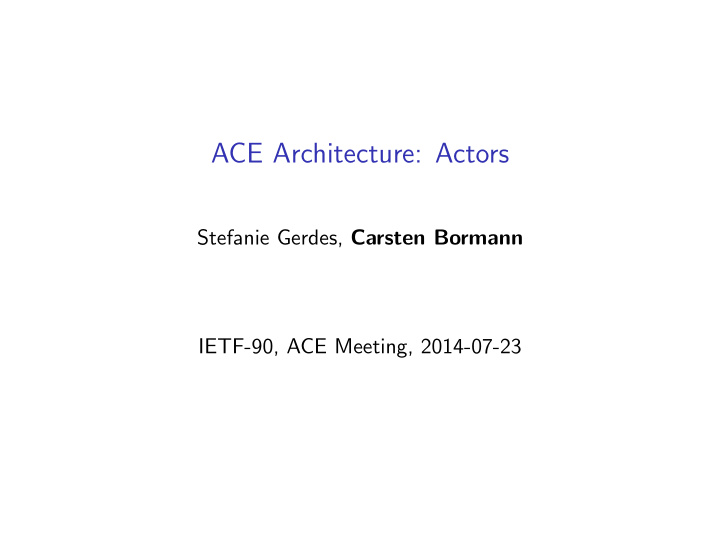



ACE Architecture: Actors Stefanie Gerdes, Carsten Bormann IETF-90, ACE Meeting, 2014-07-23
Problem Statement ◮ A Client (C) wants to access an item of interest, a resource (R) on a Resource Server (RS). ◮ A priori, C and RS do not know each other, have no trust relationship. They might belong to different security domains. ◮ C and / or RS are located on a constrained node. 2 / 21
Constraints ◮ “constrained” is defined in RFC 7228 ◮ i.e., Class-1 ( ≈ 10/100 KiB) or Class-2 ( ≈ 50/250 KiB) ◮ One or both of C and RS are “constrained” ◮ in terms of power, memory, storage space. ◮ may not have user interfaces and displays. ◮ can only fulfill a limited number of tasks. ◮ may not have network connectivity all the time. ◮ may not be able to manage complex authorization policies. ◮ may not be able to manage a large number of keys. ◮ address this by associating a less-constrained device to each constrained device for one or more of those difficult tasks 3 / 21
Possible Scenarios Constrained or not constrained: 1. C is constrained and RS is less constrained 2. RS is constrained and C is less constrained 3. C and RS are constrained Ownership: 1. C and RS belong to the same owner 2. C and RS belong to different owners 4 / 21
Basic Security Requirements ◮ Confidentiality and integrity of R: No unauthorized device must be able to access (or otherwise gain knowledge of) R. ◮ RS needs to know if C is allowed to access R ◮ RS needs to make sure that it provides the resource only to C. ◮ Access requests and the corresponding answers can both contain resource values and must be protected accordingly. ◮ Authenticity of R: C must access the proper R. ◮ C needs to know if R as offered by RS is the resource it wants to access. 5 / 21
Tasks ◮ Constrained devices must be able to limit their tasks ◮ Some tasks must be performed on constrained devices for security ◮ Authentication-Related Tasks: 1. Attribute-Binding: Validate that the entity in possession of a certain verifier (a key) really has certain attributes and make that verifiable by adding endorsement information. 2. Verifier Validation: Check the endorsement information. 3. Authentication: The verifier is used for authentication. ◮ Authorization-Related Tasks: 4. Configuration of authorization information. 5. Obtaining the authorization information. 6. Authorization Validation: map the attributes which are validated by authentication to the authorization information 7. Authorization Enforcement: Act according to the result of the authorization validation, e.g. grant access to a resource. 6 / 21
Actors ◮ Actors are model -level ◮ defined by their tasks and characteristics ◮ Several actors MAY share a single device. ◮ Several actors MAY be combined in a single piece of software. ◮ for a specific application ◮ for a specific protocol ◮ Do not prematurely reduce model to one application/protocol 7 / 21
Constrained Level Actors ◮ C and RS are constrained level actors: able to operate on a constrained node. ◮ C and RS must perform the following tasks: ◮ Validate possession of attributes and authenticate ◮ Validate and enforce authorization ◮ Securely transmit messages 8 / 21
Principal Level Actors ◮ C and RS are under control of principals in the physical world. ◮ CO is in charge of C: Configures security policies, e.g. with whom RS is allowed to communicate. ◮ RO is in charge of RS: Configures security policies, e.g. authorization policies. 9 / 21
Less-Constrained Level ◮ AM is aiding C in authenticating RS and determining if RS is an authorized source for R. ◮ AS is aiding RS in authenticating C and determining C’s permissions on R. ◮ AM and AS act on behalf of their respective owner. 10 / 21
Actors vs. Entities (Devices / Software) ◮ Several actors may share a single device. ◮ Several actors may be combined in a single piece of software. 11 / 21
Levels ◮ Three Levels of Competence: Constrained Level, Less-Constrained Level, Principal Level. ◮ Different Requirements on each level. ◮ Principal Level out of Scope in ACE. 12 / 21
Do we need to model the principals? 13 / 21
Do constrained devices even talk among themselves? 14 / 21
Or just with the Cloud? 15 / 21
Cloud? 16 / 21
Security Domains ◮ A priori, C and RS do not know each other, may belong to different security domains ◮ Owners want to keep control over their data. 17 / 21
Example: Container Monitoring Use Case ◮ A fruit vendor grows bananas in Costa Rica for the German market. ◮ The fruits have to be transported to Germany and stored in a ripening facility. ◮ During transport and storage the fruits have to be cooled and ventilated. ◮ Fruits need to be cooled constantly and evenly spread. ◮ Fruits need to be ventilated evenly: Ethylene gas is needed for ripening but too much ethylene leads to early decay of the fruits. ◮ Use sensors to control temperature and ventilation. 18 / 21
Seamless Cooling and Ventilation ◮ The cooling and ventilation system of the transportation vehicle needs to communicate with the banana box sensors. ◮ The fruit vendor configures authorization policies for the sensors. ◮ The transport company configures authorization policies for the fans. 19 / 21
Constrained to Constrained, Cross-Domain ◮ Enable constrained devices of different owners to communicate ◮ Enable dynamic seamless integration with minimal configuration: Once configured, an owner does not have to touch the device ◮ Flexibility: No painful reconfiguration for every interaction with a foreign device (and the respective authorization server) 20 / 21
Thank you! 21 / 21
Recommend
More recommend